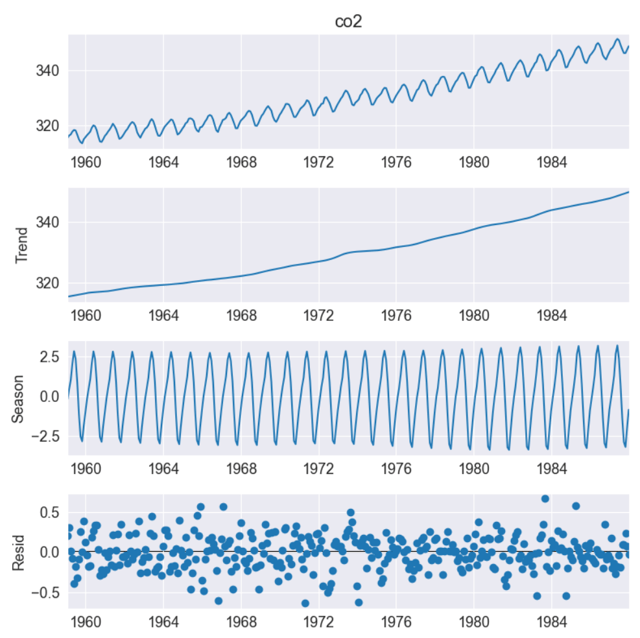I produce the following plot using statsmodels STL:
The output is displayed using matplotlib.pyplot.
I would like to get the data from the lines but can't figure out how to extract them, even after trying the recommended solutions here.
How can I 'extract' the underlying data for each of the 4 lines?
I need to do this to actually use the output.
Code:
import pandas as pd
import seaborn as sns
import matplotlib.pyplot as plt
from pandas.plotting import register_matplotlib_converters
from statsmodels.tsa.seasonal import STL
register_matplotlib_converters()
sns.set_style('darkgrid')
plt.rc('figure',figsize=(8,8))
plt.rc('font',size=13)
raw = [
315.58, 316.39, 316.79, 317.82, 318.39, 318.22, 316.68, 315.01, 314.02, 313.55,
315.02, 315.75, 316.52, 317.10, 317.79, 319.22, 320.08, 319.70, 318.27, 315.99,
314.24, 314.05, 315.05, 316.23, 316.92, 317.76, 318.54, 319.49, 320.64, 319.85,
318.70, 316.96, 315.17, 315.47, 316.19, 317.17, 318.12, 318.72, 319.79, 320.68,
321.28, 320.89, 319.79, 317.56, 316.46, 315.59, 316.85, 317.87, 318.87, 319.25,
320.13, 321.49, 322.34, 321.62, 319.85, 317.87, 316.36, 316.24, 317.13, 318.46,
319.57, 320.23, 320.89, 321.54, 322.20, 321.90, 320.42, 318.60, 316.73, 317.15,
317.94, 318.91, 319.73, 320.78, 321.23, 322.49, 322.59, 322.35, 321.61, 319.24,
318.23, 317.76, 319.36, 319.50, 320.35, 321.40, 322.22, 323.45, 323.80, 323.50,
322.16, 320.09, 318.26, 317.66, 319.47, 320.70, 322.06, 322.23, 322.78, 324.10,
324.63, 323.79, 322.34, 320.73, 319.00, 318.99, 320.41, 321.68, 322.30, 322.89,
323.59, 324.65, 325.30, 325.15, 323.88, 321.80, 319.99, 319.86, 320.88, 322.36,
323.59, 324.23, 325.34, 326.33, 327.03, 326.24, 325.39, 323.16, 321.87, 321.31,
322.34, 323.74, 324.61, 325.58, 326.55, 327.81, 327.82, 327.53, 326.29, 324.66,
323.12, 323.09, 324.01, 325.10, 326.12, 326.62, 327.16, 327.94, 329.15, 328.79,
327.53, 325.65, 323.60, 323.78, 325.13, 326.26, 326.93, 327.84, 327.96, 329.93,
330.25, 329.24, 328.13, 326.42, 324.97, 325.29, 326.56, 327.73, 328.73, 329.70,
330.46, 331.70, 332.66, 332.22, 331.02, 329.39, 327.58, 327.27, 328.30, 328.81,
329.44, 330.89, 331.62, 332.85, 333.29, 332.44, 331.35, 329.58, 327.58, 327.55,
328.56, 329.73, 330.45, 330.98, 331.63, 332.88, 333.63, 333.53, 331.90, 330.08,
328.59, 328.31, 329.44, 330.64, 331.62, 332.45, 333.36, 334.46, 334.84, 334.29,
333.04, 330.88, 329.23, 328.83, 330.18, 331.50, 332.80, 333.22, 334.54, 335.82,
336.45, 335.97, 334.65, 332.40, 331.28, 330.73, 332.05, 333.54, 334.65, 335.06,
336.32, 337.39, 337.66, 337.56, 336.24, 334.39, 332.43, 332.22, 333.61, 334.78,
335.88, 336.43, 337.61, 338.53, 339.06, 338.92, 337.39, 335.72, 333.64, 333.65,
335.07, 336.53, 337.82, 338.19, 339.89, 340.56, 341.22, 340.92, 339.26, 337.27,
335.66, 335.54, 336.71, 337.79, 338.79, 340.06, 340.93, 342.02, 342.65, 341.80,
340.01, 337.94, 336.17, 336.28, 337.76, 339.05, 340.18, 341.04, 342.16, 343.01,
343.64, 342.91, 341.72, 339.52, 337.75, 337.68, 339.14, 340.37, 341.32, 342.45,
343.05, 344.91, 345.77, 345.30, 343.98, 342.41, 339.89, 340.03, 341.19, 342.87,
343.74, 344.55, 345.28, 347.00, 347.37, 346.74, 345.36, 343.19, 340.97, 341.20,
342.76, 343.96, 344.82, 345.82, 347.24, 348.09, 348.66, 347.90, 346.27, 344.21,
342.88, 342.58, 343.99, 345.31, 345.98, 346.72, 347.63, 349.24, 349.83, 349.10,
347.52, 345.43, 344.48, 343.89, 345.29, 346.54, 347.66, 348.07, 349.12, 350.55,
351.34, 350.80, 349.10, 347.54, 346.20, 346.20, 347.44, 348.67
]
co2 = pd.Series(raw, index=pd.date_range('1-1-1959', periods=len(raw), freq='M'), name = 'co2')
co2 = co2.interpolate(method='spline', order=3)
stl = STL(co2, period = 12, seasonal=13)
stl.fit().plot()
plt.show()


STLis here – Locus